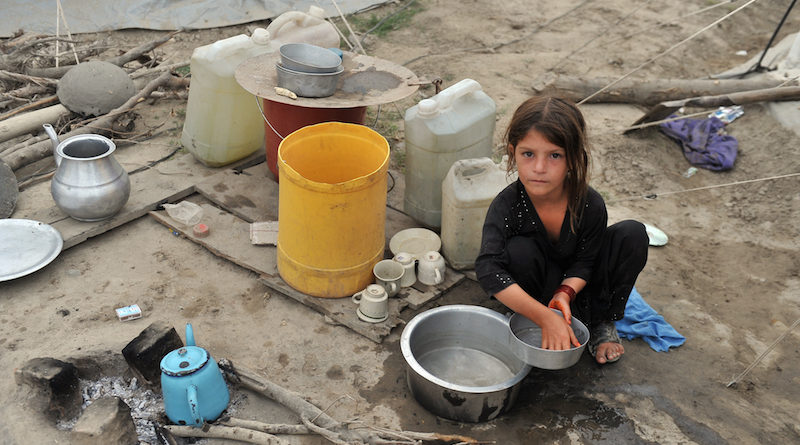This article is the first of three articles on Care Economy and its critical role in development.
From time immemorial, care work has been considered a female ‘prerogative’. Stemming from a patriarchal mindset, care-giving responsibilities to the young and old alike are presumed to be mainly a woman’s job. All across the world, women spend disproportionately more time doing care work with little to no remuneration.
Additionally, care work either goes unacknowledged to even being relegated to the lowest familial ranks and/or positions in the labor market, confining women to gendered and societally segregated roles of child-raring and domestic work. Thus arises the notion of the “Second Shift” – the idea of not only being grievously under-paid, under-valued, but also grossly exploited.
Eastern societies, especially focusing those in the Sub-continent, have emerged from an agrarian-feudalistic civilization. These regions have historically based their values on the commodification of means of production. With feudalism sanctioning the male gender and those in power to brazenly extract produce and surplus from direct producers, such societies characteristically subordinate those economically challenged and/or physically weak, from the serfs to the women and children. Thus giving rise to unequal economic relations and social reproduction; paving way to oppressively gendered hierarchies.
According to Nancy Folbre in her book, ‘Greed, Lust and Gender: A History of Economic Ideas published by the Oxford University Press: “Patriarchal feudalism could be described as a set of implicit exchanges in which the subordinated parties (whether serfs, women, or children) received protection and security in return for working long hours in the service of their superiors—relations between lords and serfs have been described in these amicable terms. But these exchanges were enforced by threat of violence as well as weight of political and military power. A variety of collective interests were at work: lords benefited from the extraction of labor dues from serfs; men benefited from a division of labor that assigned women the least remunerative forms of work; and parents benefited from their children’s labor and support. None of these relationships left much scope for individual choice. Feudal lords, for the most part, inherited their land and privilege. Men, having chosen a wife, were legally bound for life.”
Historically speaking, this patriarchal hegemony can also be seen in the Middle East, with supreme authority over women possessed by her male counterpart in the shape of her father, brother and husband.
This belief system sees and places care responsibilities solely on to women’s shoulders; creating an unfair feminization of social reproduction cycle. Irrespective of being stereotyped, her role gendered and segregated, the woman still plays her critical as the primary caregiver of her children, a ‘nurturer’ of her husband’s well-being to looking after the weak and old.
Cultural diversity in the Sub-continent
 A land possessing diverse array of communities, religions, ethnicities and race, the Sub-continent is home to indigenous people as well as settlers from Central Asia, Persia, Africa, the Middle East and even Europe who came in the form of numerous invasions. Not only did these invaders and settlers bring in new ideas and were agents of change – both positive and negative, they played a critical role in diversifying as well as assimilating differentiating cultural norms and mindset of the local communities.
A land possessing diverse array of communities, religions, ethnicities and race, the Sub-continent is home to indigenous people as well as settlers from Central Asia, Persia, Africa, the Middle East and even Europe who came in the form of numerous invasions. Not only did these invaders and settlers bring in new ideas and were agents of change – both positive and negative, they played a critical role in diversifying as well as assimilating differentiating cultural norms and mindset of the local communities.
From the Huns, Mongols to the Turks, Greeks and Afghans, these invaders, thieves as well as settlers brought in a culture that was ruled by an unquenchable thirst for power, resulting in the invasion of land and all means of production.
History is replete with stories of women maintaining a high status in ancient Indian society, though that position gradually eroded during the medieval and modern times. This was a direct result of – among other factors mentioned above – the introduction of forced labor of the poorer population of Sudras.
By and by, women’s status in the agrarian sub-continent hit rock bottom as feudalistic exploitation grew. As a consequence, it magnified the commodification of women as a means of production. Not only did this emerging ‘norm’ completely ignore care and domestic work as real work, it even went on to overlook the woman’s untiring efforts outside the home and on the lands.
The society was eventually shaped into an ironically patrilineal one. Women had the double burden of work within the confines of their homes as well as outside chores from bringing in water to tending the crops etc. It was indeed a dire situation as they did not even have the right to bodily and financial autonomy, let alone be recognized as pivotal players in economic and social development. And the status quo largely remains the same.
Post partition, the Sub-continent has experienced a systemic decline in the status of women and the consequent rise of gender inequalities; be it bodily and financial autonomy, education, inclusion in labor market based on equality. The mindset has changed little over the last several centuries.
By and by, women’s status in the agrarian sub-continent hit rock bottom as feudalistic exploitation grew. As a consequence, it magnified the commodification of women as a means of production. Not only did this emerging ‘norm’ completely ignore care and domestic work as real work, it even went on to overlook the woman’s untiring efforts outside the home and on the lands.
In the book ‘Women of Pakistan: Two Steps Forward, One Step Back’, the writers shed light about the plight of Pakistani women: “The majority of Pakistani womanhood belongs to the silent and unmentioned peasantry in the rural areas and the working class in the industrial centers. It is a poor and virtually illiterate majority, which leads a life of physical hardship involving long hours at tedious chores, for which there is neither compensation nor recognition. Most of these women bear the double burden of housework and outside work. Consequently, they are the first to rise and the last to sleep. They must light the fire, prepare breakfast, have the dishes washed and house cleaned before setting out on their ‘working’ day. After everyone has collapsed in the bed, these women are still cleaning , clearing and preparing for the following day. Not only do the women have longer days than the rest of the family, but also being the last to eat, they eat less well and suffer from anemia and malnutrition. But whether a Pakistani woman belongs to the elite or the toiling masses, whether she lives in the remote villages of the tribal areas, cut off from change, or in the dynamic environment of Karachi (port city in Southern province of Pakistan), her life is governed by the same rules of patriarchy, which cut across class and regional differences to create some measure of uniformity and similarity.”
Although different shades of traditions and cultures can be found across Pakistan, Nepal, Bangladesh and India; one aspect similar is the uniformed patriarchal mindset. These societies thrive on the power relations, which tend to exploit all activities including care work performed by women even to the extent of discounting them.
Cultural uniformity in the Arab world
With deeply entrenched patriarchal mindset, women across the Arab region experience many forms of inequalities as in the rest of the world. The problems are as diverse as are the countries culturally similar in terms of tradition and belief systems.
According to famous feminist writer Nawal el Saadawi, in the book ‘Women of the Arab World’: “In some Arab countries, the law stipulates that a man has the right to prevent a woman from going outside the home without his permission, in other cases, while there is no explicit statement to this effect, a man is given the right to prevent a woman from going out to work if this conflicts with the welfare of the family; and it is the man who defines what is the welfare of the family.”
She further comments: “We know that this chasm, this separation between ‘public’ and ‘private’ was solely establish to subjugate the women to men’s control and to impose duties upon them without giving them rights… Thus they are ignoring the simplest historical truths: that the class system was founded on the slavery of women and children in the family. The scholarly definition of exploitation – imposing on a person labour from which he does not obtain the wage due from producing that labour – has remained limited to work in the factory and to the agriculture labour, and has not come to include women’s unpaid labour in the home. ”
Role of culture
It is clear that a gendered approach to care finds its roots in economic power relations, bolstered by the imposition of biased belief systems, rigid mindset and traditions as interpreted by stakeholders – in other words, those with power.
The impact of such an approach to social reproduction is cataclysmic as far as economic development is concerned. Disempowering women through discounting their labour – be it care or domestic work – has dire ramifications on development, the overall quality of life and therefore sustainability.
Safeer Ullah Khan, Executive Director of Bedari – a Pakistani NGO working for the promotion and protection of human rights of girls, boys, women and other marginalized groups of society, explains: “Culture plays a very important role in setting gender norms, and unfortunately, culture is heavily tilted against women. The division of labor is very clear – man is supposed to earn, and woman has to take care of the house. As the financial earning is responsibility of the man, hence the monetary control also remains with him. The woman takes up the role of the caregiver, which is inherently unpaid job, so she remains dependent on man (on father in her early life, on husband in her middle life, and on son in her later life). In rural areas, she has added responsibilities of fetching water, collecting woods for fire, and rearing animals. This makes her overworked, having no time for herself or leisure. The gender roles are so clearly defined that it becomes nearly impossible for men to come to the support of their women even if they want to. The social pressure is so great to adhere to your gender role that you just can’t breach it. In some parts of Pakistan, if a man is seen hugging or kissing or carrying his child, (let alone bathing his child or changing the child’s clothes), the entire community would be making fun of him. If a man does any chores assigned to a woman by the society, the man is taunted for being feminine or slave of his wife (to be very specific). The situation, however, is slowly changing, especially in urban areas. Similarly, taking care of animals is also primarily the responsibility of women. Please note that these animals are domesticated animals kept for their utility (milk, eggs, use in agricultural activities etc.), not as personal pets.”
The impact of a gendered approach to social reproduction is cataclysmic as far as economic development is concerned. Disempowering women through discounting their labour – be it care or domestic work – has dire ramifications on development, the overall quality of life and therefore sustainability.
Adding further: “Culture puts the responsibility of care giving exclusively on women’s shoulders, making life difficult for them. I don’t know about other societies, but in Pakistan men are actively discouraged from sharing the care related responsibilities by the society, which means it would take really long to change the mindset, and bring any improvement in women’s lives. And because they are mostly caring for their own children, husband, or in laws, women are not supposed to ask for money as it would be highly offensive to make such a demand. Any woman making such a demand would be severely censured by the entire community. Though it is a very important job, its importance is not acknowledged by the family/community/society or even the State.”
Care work impacts all of us yet it is hardly recognized or endorsed as so! To achieve global goals and most importantly gender equality in every socio-economic sphere of society, recognizing and elevating the status of care work is a must. Rights-based policies and laws on the premise of shared responsibilities by all stakeholders (individuals, public and private sectors) are fundamental stepping-stones to achieve this end.
Additionally, gender-sensitive education and awareness that promotes co-sharing of responsibilities is important as it has the power to fracture stereotypes within the family and community.
Until our hegemonically patriarchal mindset is not completely dismantled, all will remain but a bombastic rhetoric!
More articles on Cultures of Care











